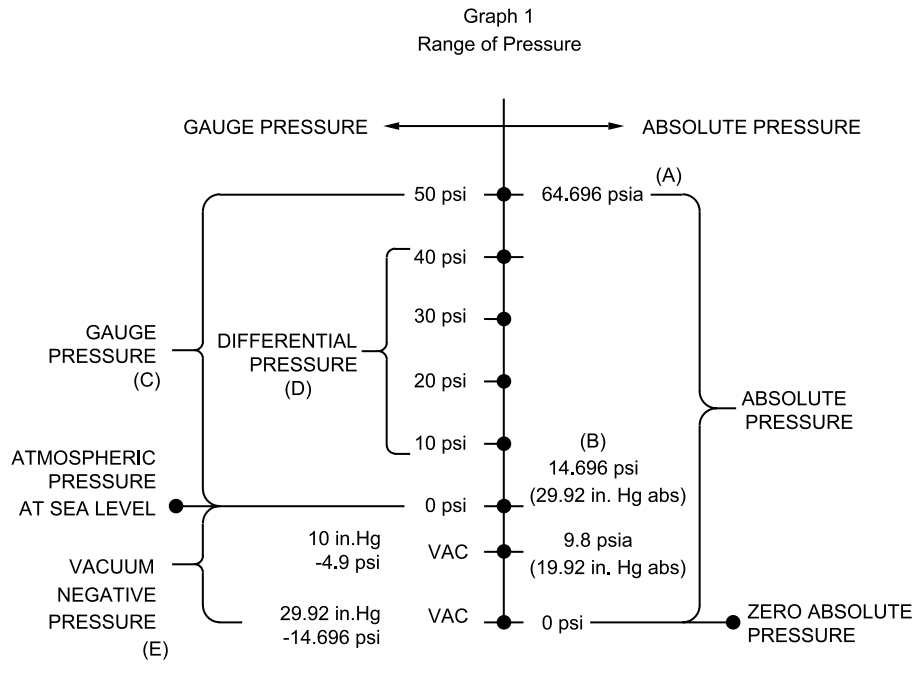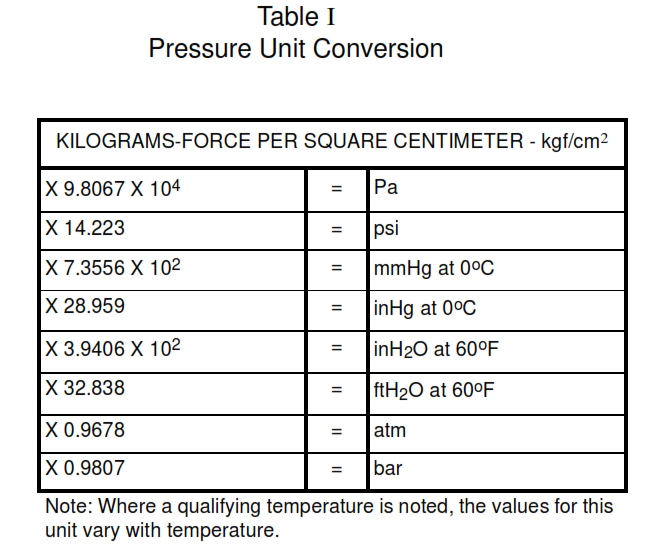Pressure is a fundamental physical quantity that is used in various fields, including engineering, physics, meteorology, and medicine. It represents the force exerted on a surface per unit area and is measured using different units depending on the application and system of measurement. Basic formula of pressure is P = F/A.
In this article, we will explain the most commonly used pressure measurement units, their conversions, and their applications in different industries.
Range of Pressure.
Refer to below picture Graph 1 for the range of different types of pressure.

Based on standard atmospheric pressure = 14.696 psia or 29.92 inches Hg abs.
(A) Absolute pressure measured above a perfect vacuum.
(B) Atmospheric pressure measured exerted by the earth’s atmosphere (= 14.7 psi).
(C) Gauge pressure measured above atmosphere.
(D) Differential pressure is the difference between two pressures.
(E) Vacuum is a pressure less than atmosphere.
Pressure Measurement Definitions.
Following definitions are needed to understand pressure measurement units.
- Absolute Pressure. The pressure measure relative to zero pressure (vacuum).
- Ambient Pressure. The pressure of the medium surrounding a device.
- Atmospheric Pressure. The barometric reading of pressure exerted by the atmosphere. At sea level it is 14.7 lb/in².
- Differential Pressure. The difference in pressure between two points of measurement.
- Elevation, Elevated Zero. A range in which the zero value of the measured variable of measure signal is greater than the lower range value.
- Gauge Pressure. Pressure measured relative to ambient pressure.
- Pressure Elements. The portions of a pressure-measuring gauge that move or are temporarily deformed by the system pressure, the amount of movement or deformation being proportional to the pressure.
- Range. The region between the limits within which a quantity is measured received, or transmitted, and which is expressed by stating the lower and upper range values.
- Suppression, Suppression Zero. A range in which the zero value of the measured variable is below the lower range value.
- Vacuum. A low-pressure gaseous environment having pressure lower than ambient atmospheric pressure.
Pressure Measurement Units.
Because of the relationship that pressure has to a system as fundamental parameter, its measurement is of crucial importance and wide ranges of this measurement with variable degrees of accuracy are required.
Pressure Units.
In the MKS system of measurement, pressure is expressed as kilogram per square meter kg/m.
1. Pound per Square Inch (psi):
Standard unit of Pressure in English (FPS) system is pound per square inch or ‘psi’
- The pound per square inch is a unit of pressure commonly used in the United States and other countries that use the imperial system.
- It is defined as the pressure exerted by a force of one pound-force applied to an area of one square inch.
- Conversions: 1 psi ≈ 6.895 kPa, 1 psi ≈ 51.715 mmHg.
3. Pascal (Pa):
In Standard International (SI) units, pressure is measured as Newton per square meter or Pascal (Pa). The larger unit kPa shall be used.
- The Pascal is the SI unit of pressure, defined as one newton per square meter.
- It is commonly used in scientific and engineering applications, especially in fluid mechanics, materials science, and thermodynamics.
- Conversions: 1 Pa = 1 N/m², 1 kPa = 1000 Pa.
4. Bar (bar):
Bar (Barometric Pressure) = one atmosphere.
- The bar is a unit of pressure equal to 100,000 Pascals or 100 kilopascals (kPa).
- It is widely used in the automotive, aviation, and meteorological industries for measuring atmospheric pressure and tire pressure.
- Conversions: 1 bar = 100 kPa, 1 bar ≈ 0.987 atm.
5. Millimeter of Mercury (mmHg):
Other pressure units preferred are mmH2O or mmHg.
- The millimeter of mercury is a unit of pressure based on the height of a mercury column in a barometer.
- It is commonly used in medicine and meteorology.
- Conversions: 1 mmHg ≈ 133.322 Pa, 1 mmHg ≈ 1 Torr.
6. Kilopascal (kPa):
- The kilopascal is a unit of pressure equal to one thousand pascals.
- It is commonly used in engineering and industrial applications.
- Conversions: 1 kPa = 1000 Pa, 1 kPa ≈ 0.145 psi.
7. Atmosphere (atm):
- The atmosphere is a unit of pressure equal to the average atmospheric pressure at sea level on Earth, approximately 101.325 kilopascals or 14.7 pounds per square inch (psi).
- It is commonly used in meteorology and weather forecasting.
- Conversions: 1 atm = 101.325 kPa, 1 atm ≈ 760 mmHg.
8. Torr (Torr):
- The torr is a unit of pressure equal to 1/760th of one standard atmosphere, approximately equal to 133.322 pascals.
- It is commonly used in vacuum technology and low-pressure applications.
- Conversions: 1 Torr ≈ 133.322 Pa, 1 Torr ≈ 1 mmHg.
Pressure Unit Conversion.
Refer to Table I for Pressure Unit Conversion.

Understanding pressure measurement units is essential for accurate and reliable measurements in various fields. Whether you’re designing a hydraulic system, monitoring atmospheric pressure, or measuring tire pressure, instrumentation and control engineering, choosing the right pressure unit ensures consistency and compatibility with standards and conventions.
By familiarizing yourself with the different pressure units and their conversions, you can effectively interpret and communicate pressure measurements in your respective field of work.